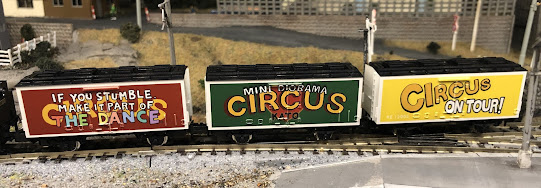Late in November, I was at the Warners model railway exhibition at the Birmingham NEC helping out on the Kato stand. That was fun, if exhausting! As well as showcasing the Mini Diorama Circus, the new EC-1 controller was on the stand for visitors to try out. Based on the real controls of a Japanese multiple unit, this is an expensive but very fun piece of kit that works nicely with the Sound Box to deliver a more immersive driving experience.
Commemorating the Mini Diorama Circus were these wagons, sold as pre-coloured kits for £10 a piece. Using a Japanese insulated goods van as their basis, the colourful liveries (designed by Akiko Takasaki) are, of course, fictitious.
Background
These appear to be based on the RE 12000 insulated wagon that were in use on JNR between 1954 and 1986. Ice was placed in compartments on the roof, and the cold air produced would keep the contents of the van nice and fresh.
Maximum speed was 75 km/h.
Kato 'Mini Diorama Circus' versions
The Kato model is normally supplied ready-to-run. One version is supplied in the Kato 10-033 freight car pack, described elsewhere. On the roof, the hatches for placing ice can be seen, while a ladder is moulded on one end of the body that presumably gave access to these hatches when fresh ice needed to be added. But the three models reviewed here are supplied as kits, and as far as I know, only at Kato Mini Diorama Circus events.
There are three versions, which for the sake of simplicity I will call the 'red', 'green', and 'yellow' wagons. All are assembled in the same way. First, the wheels are clipped into the chassis, and then the metal weight placed onto a slot on the top of the chassis. The chassis includes built-in Rapido couplings. The painted body work is actually a sort of sleeve that slides onto a rectangular core that includes the roof. Once these two pieces are pushed together, they are clipped onto the chassis which secures the metal weight in place.
As should be clear, the wagons are essentially identical except for the coloured sleeve that features the bodyside details as well as the paintwork. Needless to say, there are no separately fitted details of any sort.
The 'red' wagon sports different affirmations on each side, encouraging modellers to enjoy their dioramas. Foxes are a bit of theme in the publications that go with the Mini Diorama Circus, in part because in Japanese mythology they are able to do magic, including being able to turn into humans. In the Kato literature, some of these foxes (and badgers) enjoy making Mini Dioramas!
The 'green' wagon has the Kato branding on one side, and an 'art is love' affirmation on the other. Finally, the 'yellow' van is the most eye-catching of the three, I think, with a simple statement on one side and a picture of a ticket on the other. If you look closely, you can see that the ticket is 'priceless' and dated to 2025.
Performance is up to the usual Kato standards, but relevant to modellers building Mini Circus Dioramas, these wagons handle 15-cm radius curves just fine. A nice touch is that all three sport Re 12xxx numbers, as befitting JNR wagons: 12001 is the green van, 12002 the yellow one, and 12003 the red van.
Conclusion
These models sold well on the day, with a lot of people clearly buying them as fun mementoes of their day trip to Birmingham. For sure, if you were buying plain vanilla Re 12000 vans from Japan, they'd cost half as much as these -- but these Mini Circus Diorama models are much more attractive models.
But what strikes me about these models is how easily they could be used to make a 'real' circus train. Weathered a bit, and then run alongside cattle trucks for the livestock and a couple of coaches for the performers, they'd be as useful on a British or American layout as a Japanese one. Sure, for a British layout you'd want to add some turned brass buffers, but that's about it.
I'm not sure how widely available these models will be. But definitely worth looking out for if you visit an event where Kato are exhibiting their Mini Circus Diorama.






No comments:
Post a Comment